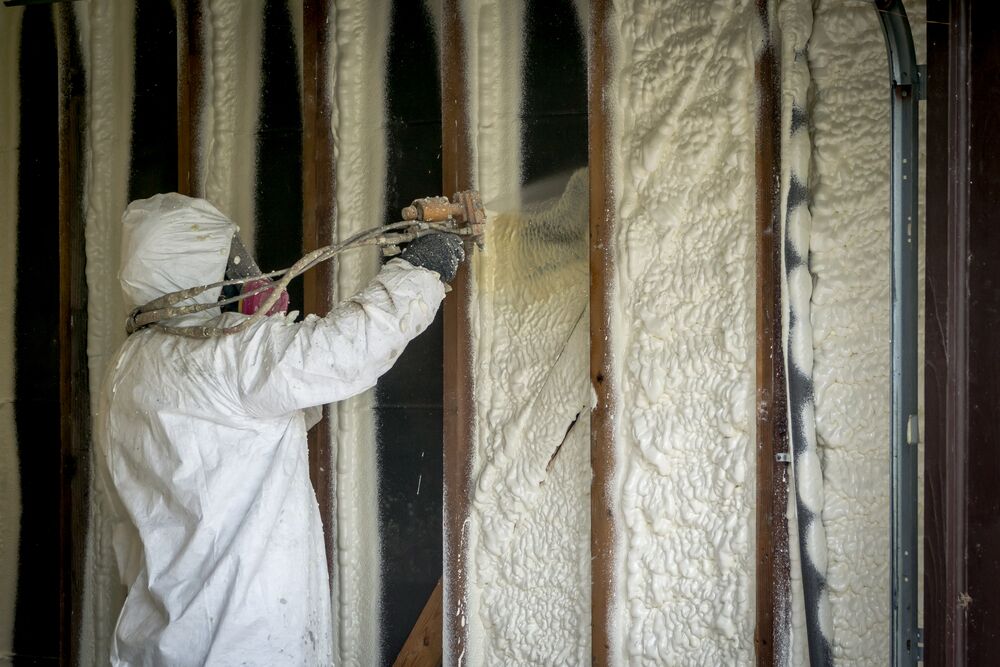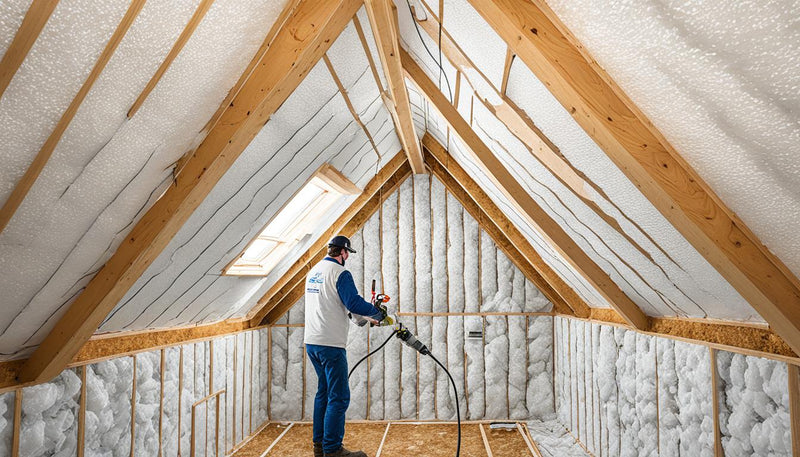Choosing the Right Type of Spray Foam for Your Insulation Needs
Choosing the Right Type of Spray Foam for Your Insulation Needs
Blog Article
Spray Foam: The Ultimate Service for Air Sealing and Insulation
Spray foam insulation has become a leading solution for efficient air securing and thermal insulation, using a distinct combination of residential or commercial properties that establish it aside from conventional approaches. Its ability to increase and load voids makes it especially effective in stopping air leakage, which can significantly influence energy performance. Nonetheless, recognizing the complete range of its benefits, installment processes, and comparisons with various other insulation kinds is essential for making educated decisions. As we check out these facets, the effects for both new buildings and retrofits come to be progressively considerable. What variables should affect your selection?
What Is Spray Foam?
Spray foam is a flexible insulation material that combines the concepts of air securing and thermal resistance to enhance energy performance in buildings. Made up primarily of polyurethane or other similar substances, spray foam is applied as a fluid that expands upon contact with surface areas, creating a solid, continual layer of insulation. This distinct building allows it to load spaces, fractures, and spaces that traditional insulation products might neglect, supplying a premium air seal.
There are two main kinds of spray foam: open-cell and closed-cell. Open-cell spray foam is lighter and much more versatile, offering excellent audio absorption and a reduced R-value per inch - Spray Foam. On the other hand, closed-cell spray foam is denser, providing a greater R-value, moisture resistance, and added architectural honesty to developing components
The application procedure usually involves customized equipment, making sure a smooth application that sticks to numerous substratums, consisting of metal, wood, and concrete. This adaptability makes spray foam suitable for both brand-new building and constructions and retrofitting existing frameworks. Its capability to create an impermeable obstacle dramatically contributes to lowering power usage and boosting interior air quality, therefore making it a favored option among homeowners and contractors alike.
Advantages of Spray Foam Insulation
One of one of the most considerable benefits of spray foam insulation is its exceptional capacity to create a continuous air obstacle, which effectively lessens energy loss. Unlike conventional insulation materials, spray foam increases to load gaps and splits, making sure that air leak is considerably lowered. This characteristic not only boosts power effectiveness but likewise brings about reduce energy expenses in time.
In addition, spray foam insulation provides exceptional thermal resistance, contributing to a much more steady interior setting. Its high R-value per inch permits efficient insulation in restricted rooms, making it excellent for attic rooms, walls, and crawl areas. In addition, the moisture-resistant homes of spray foam aid avoid mold and mildew and mildew growth, promoting healthier living conditions.
One more important advantage of spray foam insulation is its sound-dampening high qualities (Spray Foam). It properly decreases sound transmission between areas, creating a quieter and a lot more comfy home atmosphere. The sturdiness of spray foam likewise stands out, as it does not sag or work out gradually, maintaining its performance throughout its life-span
Just How Spray Foam Functions
Recognizing exactly how spray foam insulation works is necessary for appreciating its performance in air securing and thermal resistance. Spray foam insulation consists of two main click over here elements: isocyanate and polyol material. When these elements are mixed, they go through a chain reaction that triggers the material to increase quickly, creating a dense foam that loads cracks, spaces, and cavities.
As the foam expands, it follows surface areas, creating an airtight seal that considerably reduces air seepage. This particular makes spray foam insulation very reliable at preventing drafts and wetness penetration, which can result in power loss and damage gradually. Additionally, the closed-cell variation of spray foam supplies superior thermal resistance due to its rigid structure, efficiently lessening warmth transfer.
The one-of-a-kind residential properties of spray foam enable it to adjust to uneven surface areas, making certain thorough insurance coverage and a smooth obstacle. Therefore, spray foam insulation not only enhances energy efficiency but additionally adds to boosted interior air high quality by decreasing the accumulation of allergens and pollutants. Eventually, comprehending the mechanics behind spray foam underscores its duty as a premium option for insulation and air securing in both industrial and property applications.
Setup Refine Introduction

Prior to installation, the area has to be sufficiently cleansed and prepped, ensuring that surfaces are cost-free from dust, debris, and wetness. Since impurities can endanger attachment and overall performance, this step is important. When the location is prepared, the application entails mixing the two components of the spray foam, which broadens upon get in touch with and fills up voids properly.
Educated specialists should conduct the installation, utilizing specific devices to make sure consistent insurance coverage and optimum thickness. Safety precautions, including wearing protective gear and ensuring proper ventilation, are necessary throughout this process. After application, the foam normally treatments promptly, creating a strong barrier that enhances energy efficiency.
Contrasting Spray Foam to Typical Insulation
When examining insulation options, spray foam insulation stands out in contrast to conventional products such as fiberglass and cellulose. Unlike fiberglass and cellulose, which can enable air infiltration, spray foam broadens upon application, filling holes and gaps to develop an airtight seal.
In addition, spray foam offers a greater R-value per inch than conventional insulation kinds, over here providing even more effective thermal resistance in a thinner account. This particular is especially advantageous in rooms with limited dental caries depth. Spray foam is resistant to dampness and mold growth, which can be a substantial concern with cellulose and fiberglass, especially in moist environments.
Nevertheless, spray foam insulation commonly carries a higher ahead of time cost than its conventional equivalents. Home owners should evaluate this first investment against long-term energy financial savings and efficiency advantages. Ultimately, while both insulation types serve their function, spray foam arises as an advanced service for contemporary insulation requirements, specifically in terms of air sealing and thermal effectiveness.

Final Thought
In summary, spray foam insulation represents an extremely efficient service for accomplishing ideal air sealing and thermal resistance. Its distinct homes, consisting of dampness resistance and audio dampening, make it ideal for different applications in both new buildings and retrofitting projects (Spray Foam). The initial prices might be higher contrasted to typical insulation materials, the long-term advantages, such as considerable power cost savings and improved interior air high quality, validate the financial investment and highlight its worth in contemporary building techniques.
Spray foam insulation has arised as a leading service for effective air securing and thermal insulation, providing an one-of-a-kind combination of residential or commercial properties that establish it apart from standard methods.Spray foam is a flexible insulation material that integrates the principles of air sealing and thermal resistance to boost energy performance in buildings.When assessing insulation options, spray foam insulation stands out in comparison to typical materials such as fiberglass and cellulose. Inevitably, while both insulation types serve their objective, spray foam emerges as an extra advanced option for modern-day insulation needs, specifically in terms of air sealing and thermal effectiveness.
In recap, investigate this site spray foam insulation represents a highly reliable solution for accomplishing ideal air securing and thermal resistance.
Report this page